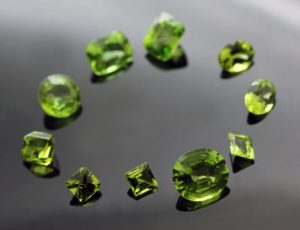
The shvitzy dog-days of summer turn into the days of Leo the Lion as we head into August. In many senses, this fifth sign in the Zodiac is the most generous and radiant of the year’s cycle, of course meaning good things for those born between July 23 and August 22, and all who are warmed in Leo’s orbit. Leo’s birthstone is officially Peridot, a gorgeous Olivine mineral with a Mohs hardness of 6.5 to 7, meaning that it’s relatively durable and safe to enjoy in your daily jewelry stack.
The name “Peridot” comes to us from the Arabic “faridat” meaning “gem.” Cleopatra famously loved green gems, usually noted in history as Emeralds. Centuries later, Peridot was tagged the “poor man’s emerald.” But many historians reason that the green jewels the Queen of the Nile loved so much may in fact have been Peridot, mined from her own royal site on an island called Topazios, now called St. John’s Island or Zabargard, in the Red Sea.


Egyptians called Peridot “the gem of the sun,” which is so appropriate for Leo, the sign ruled by the Sun. Common belief held that Peridot protected the wearer from night-terrors, especially when the stone was set in gold. Humbler folk strung the green gem on donkey hair and tied it around their left arm, to ward off bad vibes.

People in medieval times continued the mix-up, including the master artisans who in 1180–1225 CE built Christendom’s largest reliquary, the Shrine of the Three Holy Kings in Germany’s Cologne Cathedral, believed to hold the blessed bones of the Magi.

The gilded shrine includes staggering 200-carat green gems long thought to be Emeralds, which have since proven to be Peridot. The gem varies in color from blue-green to dusky olive to a brilliant, acidic, glossy lime-Granny Smith Apple-Jolly Rancher candy shade, all hues created by the presence of iron as the gem forms.

Peridot isn’t especially rare, which isn’t to say they aren’t lovely. Natural mining sites include Sardinia, Vietnam, and Oahu, where the green gems known as “Pele’s tears,” Pele being the goddess of fire, have been present for so long that they carpet the beaches in pulverized form. The volcano reference is apt since Peridot does not form in the earth’s crust as most minerals do. Instead, Peridot crystals often occur in the molten rock of the upper mantle of live volcanoes. And, some even arrive from outer space. Yes, really. Rare Pallasite meteors, remnants of our solar system’s birth which formed 4 to 5 billion years ago, brought Peridot with them when they crashed to earth. Fragments of Peridot are found in the dust of comets, and have been identified on the surface of the Moon.

As always, the assignment of birthstone to birth sign is a bit sketchy. Today, some jewelry retailers argue that sunny yellow gems—Canary Diamonds, solar-hued Sapphires and Spinels, golden Amber, and honey-hued Citrine—really should belong to Sun-ruled Leo. Metaphysical practitioners claim that red Sardonyx and even Ruby, the latter being Cancer’s birthstone, truly belong to Leo, since Leo rules the heart. This reasoning would move moody, lunar Moonstone into place as Cancer’s gem, which would seem to make perfect sense. But there’s no reasoning with the cosmos.
But back to Leo. What’s new pussycat? Strike up the band and break out the show-tunes, since this fixed Fire Sign is a born ham and often hogs the literal spotlight onstage as a performer. The leonine constellation references the great feline defeated by the Greek hero Hercules, symbolizing victory, courage, as, as in a plural of lions, pride. The sun is at its most potent during the sign of Leo, and so this sign emanates glorious, abundant energy and enjoys bathing others in life-giving light and warmth.

The strength and beauty of lions quite naturally led to the animal and the sign of Leo becoming associated with royalty and nobility. The inevitable “Godfather” reference: the family name Corleone of course means “lion-hearted.”

And it’s not an accident that lions appear in the coat-of-arms and royal regalia of hundreds of countries and civilizations from Ethiopia to England. In addition to the power of the beast itself, African lions were captured and presented as gifts to world leaders, thus signaling military might and social status. The Romans were relentless collectors of exotic animals, including lions, which they routinely slaughtered in mock-hunts staged as public entertainment, and in the gladiatorial games.

Lions appear throughout the Bible as symbols of worldly power. In the Book of Daniel, the story of a noble Jewish youth who walks the fine line between keeping his Jewish faith and being of service to the polytheistic Babylonian empire. When Daniel defies King Darius and his sorcerers, he is thrown in the proverbial lion’s den, but is unharmed because of his faith. In this context, the lions are symbols of secular worldly power which become as docile as house-pets in the righteous presence of the mighty YHVH.

Fast-forward to the Christian Middle Ages, when each of the four Evangelists, Matthew, Mark, Luke, and John, was assigned an animal symbol which represented the specific nature of their teachings. Matthew, the great humanist, is represented by a human form (often misinterpreted as an angel, since each of the four representative creatures are winged). Luke is represented by a winged ox, the ox being the symbol of utter obedience as well as representing the largest and most significant animal used for sacrificial offering in the ancient world. John is represented by the eagle, for his high-flying and mystical visions. Saint Mark is represented by the winged lion, symbol of Venice, as the most ferocious defender of the Christian faith.

Leo is perhaps the most lovable of the three Fire signs, far kinder than equally headstrong but less sympathetic Aries, and more charismatic than Sagittarius. Leo tends to be bold and extroverted and plays well with others—especially those others who let her or him win. It’s true, Leo has a touchy side, and tends to be a poor loser. Luckily, that petulance usually lasts only a moment or two, because Leo really does prefer the sunshine to the shadows. Unlike retentive Earth signs, who can stew and fester for years over the slightest slight (especially Taurus), Fire signs rarely hold a grudge. They simply don’t have the patience! If you cross a Leo in a bad way, you’ll feel those mighty fangs and the claws immediately. There’s a certain bracing vigor to this sort of emotional honesty, if you can stand the occasional emotional bloodshed.

Leo’s insistence upon being the center of attention may rub some people the wrong way, and this can lead to the top cat being misunderstood. But the truth is that Leo hates nothing more than a bully, and will always fight the good fight to protect and defend a smaller, more fragile creature, or a noble principle. In this sense, this showboat can be surprisingly selfless. These qualities make Leo a born leader, crowning the lion as the zodiac’s true champion of justice.

Get more like this—Sign up for our daily inspirational newsletter for exclusive content!
__
Photo: pexels.com and Wikimedia Commons
